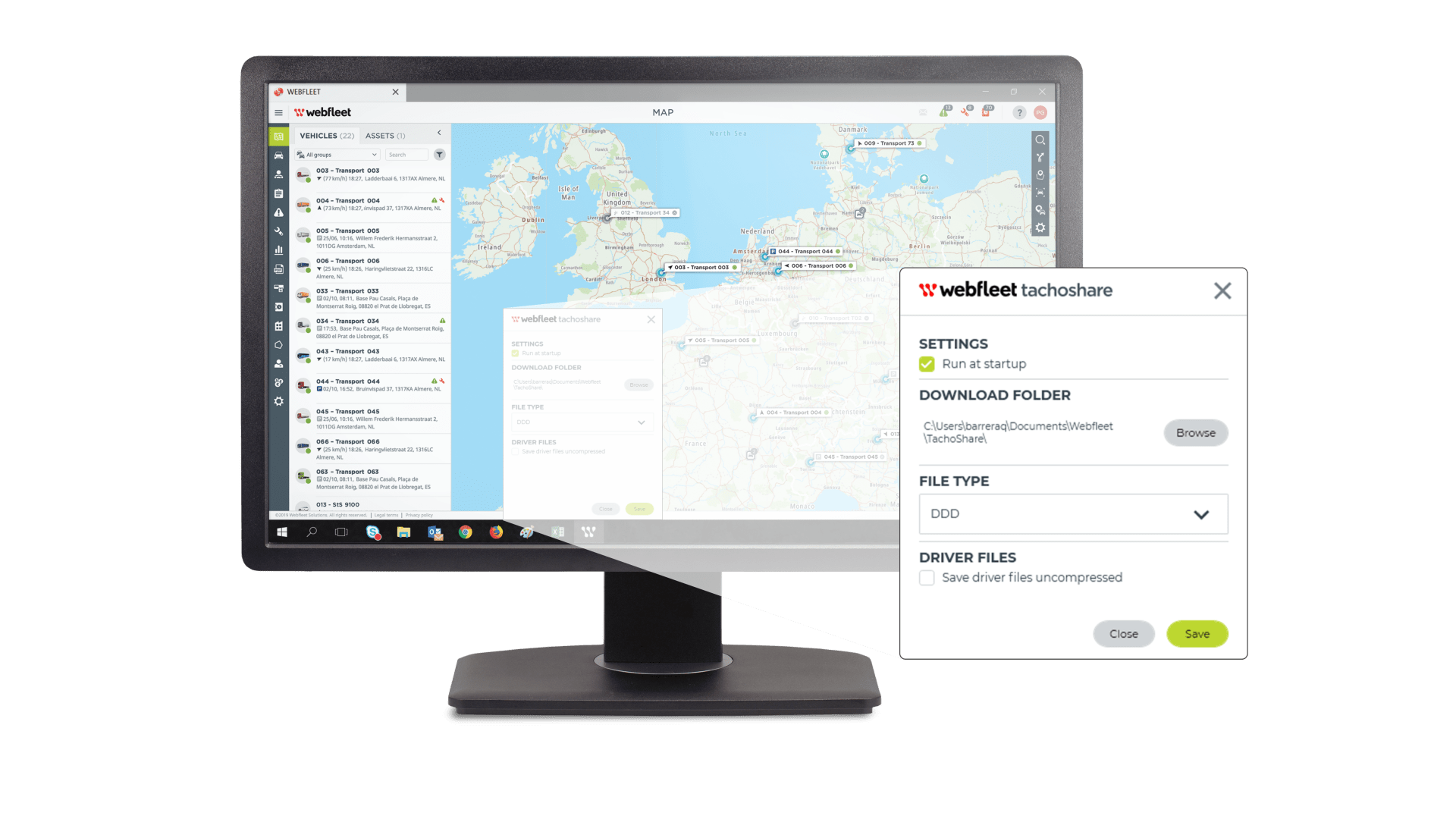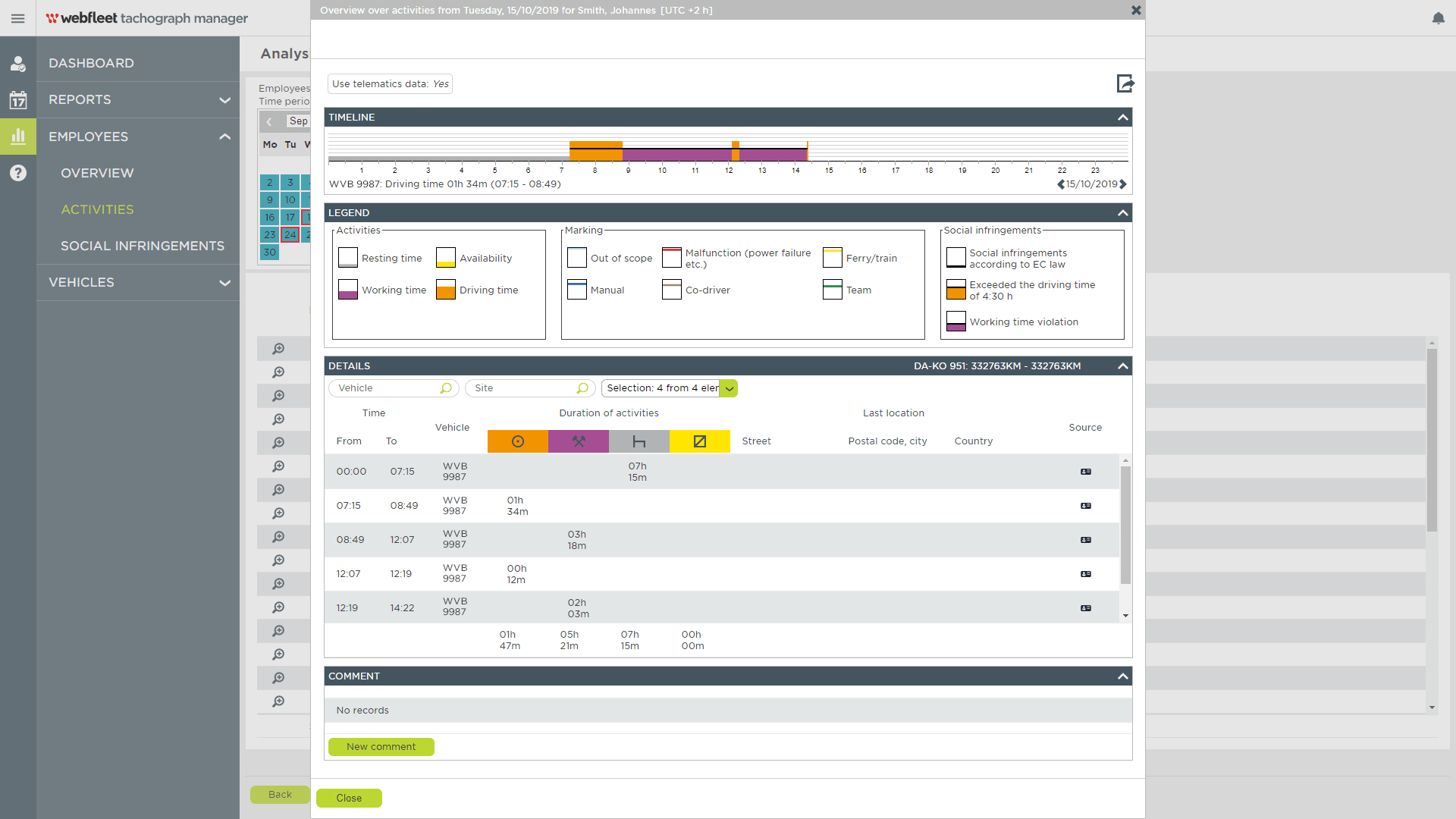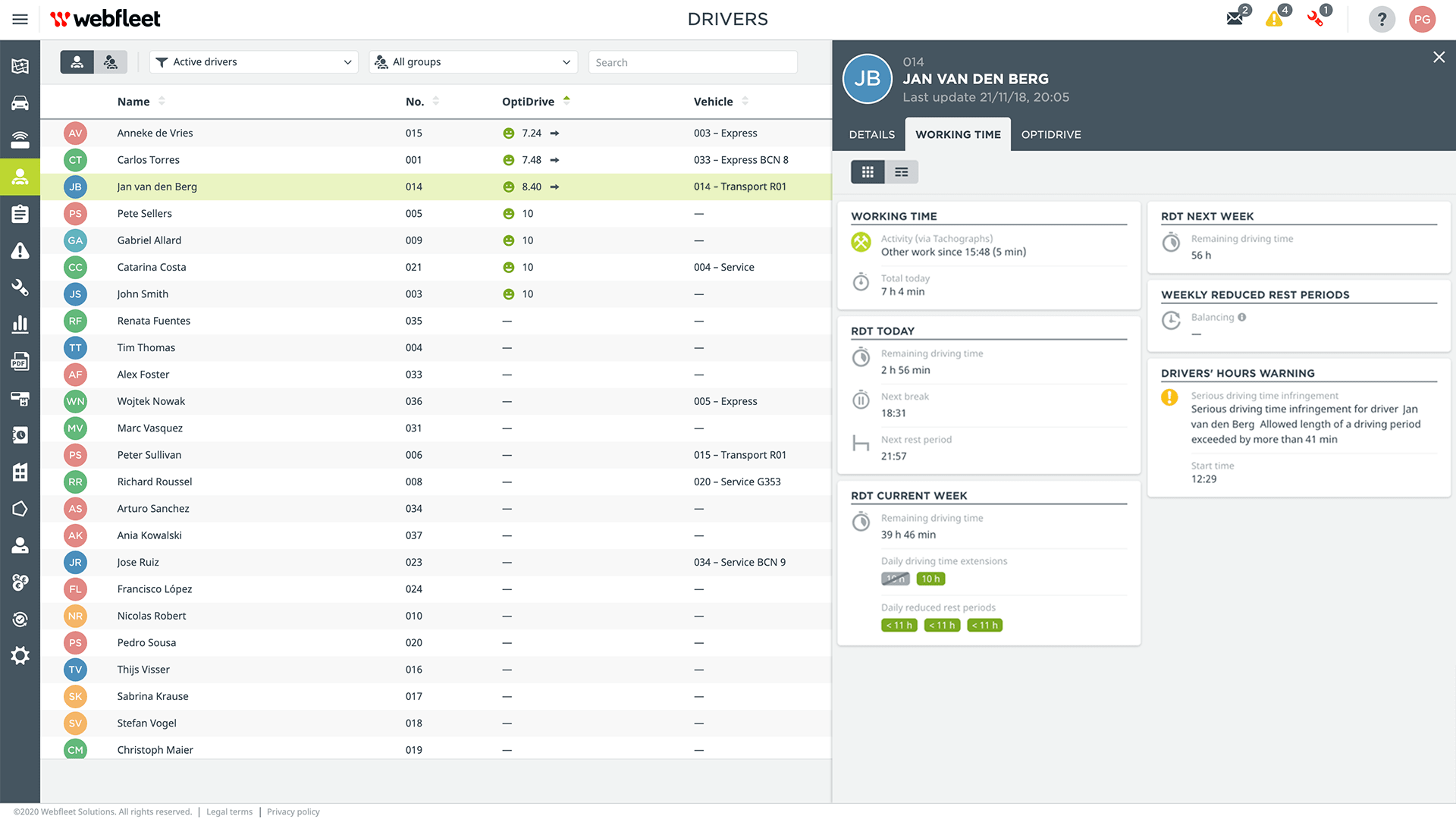





Request callback






Digital tachographs
A guide to understanding tachograph devices and regulations






Table of content
Digital tachographs and fleet compliance

Digital tachographs are crucial to fleet compliance. These devices ensure you can accurately record and report on driver activities. Are you a fleet manager, a driver or someone who's just interested in learning more about these advanced systems? This guide will provide you with a clear understanding of the functionalities, regulations and best practices surrounding digital tachographs.
Talk to one of our experts about how Webfleet can support youWhat is a digital tachograph?
Digital tachographs record data on driving time, speed, distance and driver for HGVs and buses in the UK.
These devices are mandatory for vehicles that fall under the EU drivers' hours rules, which aim to ensure road safety and fair competition in the transport sector.
Looking for a digital tachograph solution?
Get everything you need to stay compliant with Tachograph Manager.
What does a digital tachograph do?
A digital tachograph is installed in a vehicle for the purpose of tracking vehicle speed, driver break periods and mileage driven. It starts recording this data the moment a vehicle begins to move.
Digital tachographs record the following types of data:
- Vehicle speed
- Vehicle mileage
- Driving time
- Driver identity
By 2026, heavy goods vehicles weighing 2.5 tonnes or more must be equipped with smart tachograph v2 (learn more about this timeline in the “Smart tachograph v2” section below). In addition to the data mentioned above, the new digital tachographs will also record:
- Driver rest/break periods
- Availability of a driver who isn’t driving
- Border crossings
The rules around digital tachograph installations continue to evolve.
Analogue vs. digital tachographs
The main difference between analogue and digital tachographs is how data is recorded and stored. The analogue version tachographs uses charts and discs to record data, requiring drivers to manually write down start and end times and odometer readings. Digital tachographs introduced tachograph cards, which store vehicle data and driver working times for 28 days. With digital devices, data can’t be changed or erased, making it easier for authorities to enforce driver hours’ rules. Stored digitally, the data is also highly secured, since it’s encrypted and must conform to the General Data Protection Regulation, or GDPR.
Talk to an expertWhen is a digital tachograph mandatory?
The analogue tachograph first came into use in the 1950s. Since 1 May 2006, all qualifying vehicles manufactured in the EU must have been installed with a first-generation digital tachograph device.
As of June 2019, every new vehicle must be installed with a smart tachograph, a next-generation recording device. From August 2023, any newly registered HGV is required to have the smart tachograph version 2 installed. More recent legislation means that fleets will need to replace analogue tachographs and earlier digital tachographs with smart tachograph version 2. This device is part of the EU’s Mobility Package 1, which includes enforcing cabotage rules and registering border crossings, along with the loading and unloading of trucks.
Commercial fleets should be aware of two more dates:
- 31 December 2024, which is when trucks must be fitted with smart tachograph version 2
- 19 August 2025, the date by which any truck equipped with the first version of smart tachograph should be installed with version 2
Smart tachograph v2
Digital tachographs bring a high level of security and greater efficiency. An open interface allows for increased device capabilities, while a short-range communication system helps simplify daily vehicle inspections. With regulatory changes that rolled out in August 2023, all newly registered trucks are required to be installed with smart tachograph version 2.
Trucks still using smart tachograph version 1 must upgrade to version 2 by 25 August 2025. The law also stipulates that as of 1 July 2026, all vehicles weighing 2.5 tonnes or more and that are involved in international transport or cabotage operations must be equipped with version 2.
Why is a digital tachograph so important?
Like the analogue model before it, a digital tachograph tracks how far, fast and long a driver travels. The objective with smart tachographs is the same as the original analogue version: to protect drivers and make roads safer for everyone.
Digital devices are mandated by European law, making them essential to fleet compliance.
Talk to an expertWhat can you track with a digital tachograph?
A smart digital tachograph records the:
- driving time
- speed and distance of a vehicle
- driver’s identity and activities
Digital tachographs can also communicate with other devices and systems, such as GPS, dash cams and fleet management software.
With a smart tachograph, fleets can easily comply with drivers’ hours rules while optimising driver performance and fuel efficiency. They provide real-time data, ensuring greater safety and driver wellbeing.
A digital tachograph to track driver hours rules
Since digital tachographs automatically record driving times and break periods, they help fleets comply with drivers’ hours rules.
EU law limits the amount of time a driver can work and drive in a day or week. A digital tachograph helps transport companies monitor driver compliance with the rules, detecting potential violations or infringements in real time.
Get a full explanation of drivers' hours rules.How to use a digital tachograph to stay compliant?

Digital tachographs help fleet operators stay on top of compliance with drivers’ hours rules. Manually downloading analogue tachograph data can take between 20 minutes and two hours per vehicle - and drivers must be physically present in the same location as the reading equipment.
These constraints make it tricky to analyse data regularly and effectively.
With a digital tachograph, fleet managers can download data remotely, shaving hours off their administrative time. Combining this with a software analysis tool simplifies compliance, since data can be accessed in real time.
Download guideWhat kind of digital tachograph exemptions are there?

While the UK is no longer part of the EU, the rules on drivers’ hours still apply. There are, however, exemptions for digital tachographs.
Wherever a vehicle is driven in the EU, these exemptions relate to vehicle type, purpose of transport and trip start/end points. For example, vehicles used for emergency and rescue operations are exempt. Also exempt are vehicles with a maximum speed of 25 mph.
The European Commission created special UK-specific exemptions for vehicles produced before 1947, propelled by steam and those used by the Royal National Lifeboat Institution.
See the complete list of tachograph exemptions on the UK government website.
Digital tachograph cards: how to use them?
By law, all commercial bus and truck drivers must have tachograph driver cards on hand. These cards record and store the driver data that ensures fleets comply with EU rules on drivers’ hours, including work breaks and resting periods.
There are different kinds of digital tachograph cards, and your professional role may determine which card you use. For example, drivers will use driver cards that record their activities and store their individual IDs. A driver card puts responsibility on drivers to adhere to rules around working and rest times. Businesses also use company cards, enabling fleet managers to monitor driver hours and break times for fleet compliance. A driver card puts responsibility on drivers to adhere to rules around working and rest times.
Businesses also use company cards, enabling fleet managers to monitor driver hours and break times for fleet compliance.
Book a meetingWhat can Webfleet do for your transport fleet?

It takes a lot to run a transport fleet. The responsibilities seem endless: planning jobs and routes, overseeing safety and security, managing drivers, handling compliance, scheduling maintenance, reining in fuel costs and more.
Wouldn’t it be easier to manage it all on a single platform? With Webfleet’s Tachograph Manager, you can remotely download and secure your fleet’s tachograph data. Stay on top of Remaining Driving Time (RDT) and get alerts to help you avoid infringements.
All you need to know about digital tachograph
How does a digital tachograph work?
0
How does a digital tachograph work?
0Analogue tachographs required drivers to write down vehicle mileage and working times. With digital tachographs, vehicle and driver data are recorded and stored digitally. A digital tachograph records vehicle speed, driver break times and the distance a vehicle travels. Learn more about digital tachographs.
How do you use a digital tachograph?
0
How do you use a digital tachograph?
0Digital tachographs make it easier to comply with the rules on drivers’ hours. For instance, you can monitor expiration dates on driver cards. You can also stay on top of remaining driving times. A solution like Webfleet’s Tachograph Manager automates compliance processes with remote downloads, along with digital archiving and analyses. Learn more about Tachograph Manager.
What does a smart tachograph cost?
0
What does a smart tachograph cost?
0Like any fleet solution, the cost largely depends on your business needs. By 2026, all vehicles that weigh 2.5 tonnes or more must have smart tachograph v2 installed. So, the number of vehicles requiring in your fleet will play a huge role in the overall cost. One of our experts can provide you with a free quote—just request a callback and we’ll get in touch.
What are digital tachograph rules?
0
What are digital tachograph rules?
0New rules on digital tachographs came into effect in 2023, making it mandatory for fleets to install smart tachograph version 2. The rules also prohibit drivers from spending their 45-hour rest periods in their cabs. Under these new rules, national pay scales for drivers are replaced by equal pay. Learn more about smart tachograph v2.
How can you read data from a digital tachograph?
0
How can you read data from a digital tachograph?
0The most efficient way to read digital tachograph data is to use a fleet management system that includes tachograph software. Quick reporting and analyses are possible with such a system, helping you avoid social infringements and fines. With instant access to working times, you can make sure your drivers are adhering to break and rest periods. Learn more about tachograph software.
Can a driver card be inserted into the tachograph?
0
Can a driver card be inserted into the tachograph?
0The driver card must be inserted into the tachograph for compliance purposes. The digital tachograph card keeps track of driving hours and rest periods. The working driver’s card should be inserted into slot 1. When a vehicle is double manned, the non-working driver sitting in the passenger’s seat must insert their card into slot 2. Learn more about using digital tachograph cards and using driver cards for double manning.
What do the symbols on a digital tachograph mean?
0
What do the symbols on a digital tachograph mean?
0Any digital tachograph system uses four symbols. These symbols indicate when a driver is: 1. driving, 2. doing non-driving work, 3. on standby but available for work and 4. on a break or rest period. These symbols are important because they represent various aspects of compliance with drivers’ hours regulations. Learn more about digital tachograph symbols.

How to leverage your fleet’s compliance

Want to improve safety and avoid costs? Make the most of your fleet’s compliance with drivers’ hours and tachograph rules - get our quick guide.
Request callback
Talk to a specialist and discover how your business can benefit from a fleet management solution.






Request callback
Discover why Webfleet is the leading telematics solution in Europe, with more than 200,000 connected HCVs across the continent.






Request callback
Your consent is required
In this section, external content is being embedded from .
To display the content, your consent is required for the following cookie categories:
- Targeted Advertising
- Analytics & Personalization
- Essential
For further details, please refer to our privacy policy. If you are interested in how ###vendor_name### processes your data, please visit their privacy policy.












